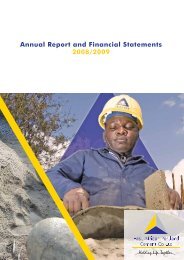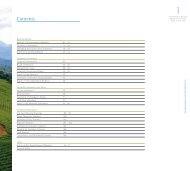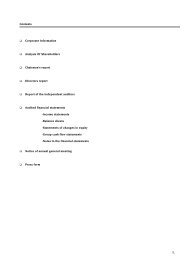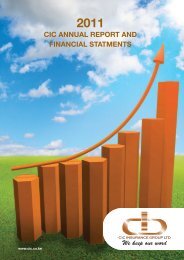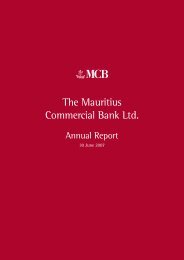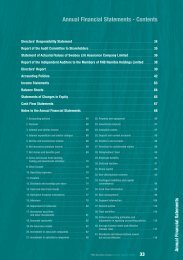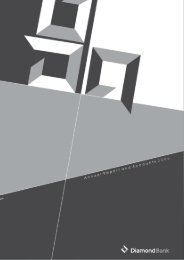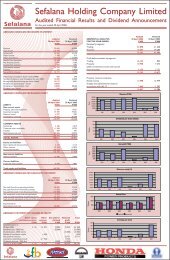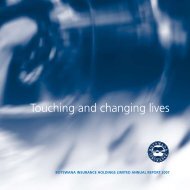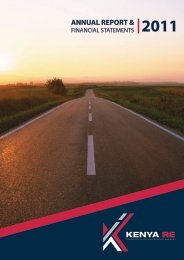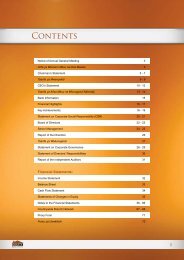CONTENTS - Investing In Africa
CONTENTS - Investing In Africa
CONTENTS - Investing In Africa
Create successful ePaper yourself
Turn your PDF publications into a flip-book with our unique Google optimized e-Paper software.
NOTES TO THE FINANCIAL STATEMENTS continued<br />
for the year ended 31st December 2007<br />
iv)<br />
Rental income<br />
Rental income is accounted for on a straight-line<br />
basis over the lease terms on ongoing leases.<br />
(e) Property, equipment and depreciation<br />
Property and equipment are stated at cost or<br />
valuation, excluding the costs of day-to-day servicing,<br />
less accumulated depreciation and accumulated<br />
impairment in value.<br />
Changes in the expected useful life are accounted for<br />
by changing the amortisation period or method, as<br />
appropriate, and treated as changes in accounting<br />
estimates.<br />
Depreciation is calculated on the straight line basis at<br />
annual rates estimated to write off the carrying values<br />
of the assets over their expected useful lives. The<br />
annual depreciation rates in use are:-<br />
Freehold land<br />
Leasehold improvements<br />
Motor vehicles 25%<br />
Furniture and fittings 10%<br />
Office equipment 20%<br />
Computers 20%<br />
Nil<br />
Rates based on the<br />
shorter of the lease<br />
term or estimated<br />
useful lives<br />
Property and equipment are periodically reviewed<br />
for impairment. If any such indication exists and<br />
where the carrying values exceed the estimated<br />
recoverable amount, the assets are written down to<br />
their recoverable amount. The recoverable amount<br />
is the greater of net selling price and value in use. <strong>In</strong><br />
assessing value in use, the estimated future cash flows<br />
are discounted to their present value using a pre-tax<br />
discount rate that reflects current market assessments<br />
of the time value of money and the risks specific to<br />
the asset. Impairment losses are recognised in the<br />
income statement.<br />
(f) Provisions<br />
Provisions are recognised when the Group has a<br />
present legal or constructive obligation as a result of<br />
past events, for which it is probable that an outflow<br />
of economic benefits will be required to settle the<br />
obligation, and a reliable estimate can be made of the<br />
amount of the obligation.<br />
The estimated monetary liability for employees’<br />
accrued annual leave entitlement at the balance sheet<br />
date is recognised as an expense accrual.<br />
(g) Financial instruments<br />
i) Loans and advances to customers<br />
Loans and advances to customers are financial<br />
assets with fixed or determinable payments<br />
and are not quoted in an active market. After<br />
initial measurement at cost, loans and advances<br />
to customers are subsequently measured at<br />
amortised cost using the effective interest<br />
rate method, less allowance for impairment.<br />
Amortised cost is calculated by taking into<br />
account any discount or premium on acquisition<br />
and fees and costs that are an integral part of<br />
the effective interest rate.<br />
ii)<br />
<strong>In</strong>vestments held for trading<br />
<strong>In</strong>vestments held for trading are those which<br />
were either acquired for generating a profit<br />
from short-term fluctuations in price or dealer’s<br />
margin, or are securities included in a portfolio<br />
in which a pattern of short-term profit-taking<br />
exists. <strong>In</strong>vestments held for trading are initially<br />
recognised at cost and subsequently remeasured<br />
at fair value based on quoted bid<br />
prices or dealer price quotations, without any<br />
deduction for transaction costs. All related<br />
realised and unrealised gains and losses are<br />
included in the income statement. <strong>In</strong>terest earned<br />
whilst holding held for trading investments is<br />
reported as interest income.<br />
Property and equipment is de-recognised upon<br />
disposal or when no future economic benefits are<br />
expected to arise from the continued use of the asset.<br />
Any gain or loss arising on de-recognition of the asset<br />
(calculated as the difference between the net disposal<br />
proceeds and the carrying amount of the item) is<br />
included in the income statement in the year the item<br />
is de-recognised.<br />
iii)<br />
Held to maturity investments<br />
Held to maturity financial investments are those<br />
which carry fixed or determinable payments and<br />
have fixed maturities and which the Group has<br />
the intention and ability to hold to maturity. After<br />
initial measurement, held to maturity financial<br />
investments are subsequently measured at<br />
amortised cost using the effective interest<br />
rate method, less allowance for impairment.<br />
44 KCB ANNUAL REPORT & FINANCIAL STATEMENTS 2007



